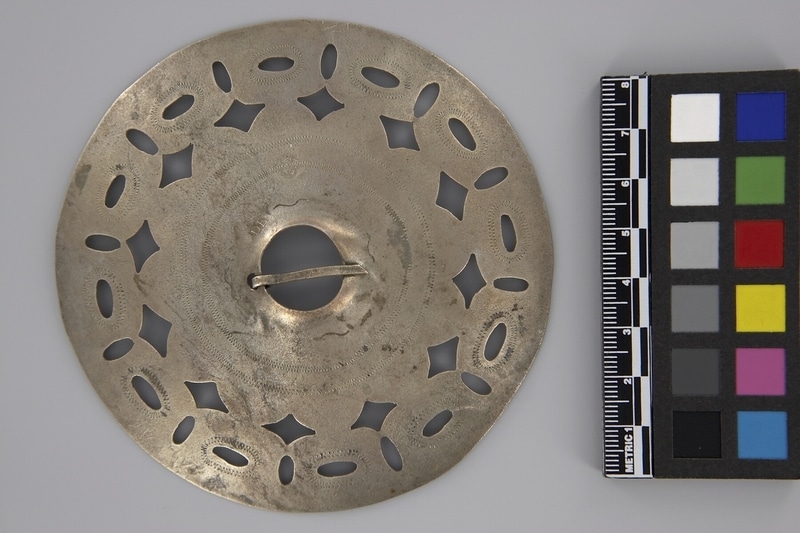Brooch Item Number: 1590/172 from the MOA: University of British Columbia

Description
Circular brooch with outer row of alternating vertical and horizontal oval cutouts, the latter outlined with engraved zigzag lines. Inner row of diamond cutouts. Engraved double zigzag lines and four small wavy lines surround central circular hole with raised edge. Cross-pin secured through hole. Dent in inner rim opposite cross-pin hole. Maker’s hallmark close to inner edge.
History Of Use
Silver ornaments represent an important part of early exchange between Europeans, including fur traders, and First Nations people, especially in eastern and central Canada and the U.S.A. Initially, the main source of silver was British, French and Spanish coins. Most ornaments were produced by silversmiths of European origin in North America and Europe, and were actively traded only from 1760 to 1821. By the mid-18th century silver objects were produced in New England, Quebec and Montreal. Silver was used by First Nations people as a sign of rank. Silver ornaments in these styles continue to be produced by native silversmiths in central Canada and the USA. Brooches were the most popular and numerous silver ornaments. They were worn on the chest, but also in the hair. Frequently, many were worn at once in rows across the chest.
Cultural Context
trade; personal decoration; status
Specific Techniques
Repousse is a type of ornamentation formed in relief in metal by hammering up from the reverse or inner side. Rocker engraving is a freehand technique. Irregularity is characteristic
Item History
- Made in Canada ? or USA ? between 1760 and 1821
- Owned by Kathleen E. Reif before September 9, 1993
- Received from Kathleen E. Reif (Donor) on September 9, 1993
What
Who
- Culture
- Eastern Woodlands
- Previous Owner
- Kathleen E. Reif
- Received from
- Kathleen E. Reif (Donor)
Where
- Holding Institution
- MOA: University of British Columbia
- Made in
- Canada ? or USA ?
When
- Creation Date
- between 1760 and 1821
- Ownership Date
- before September 9, 1993
- Acquisition Date
- on September 9, 1993
Other
- Item Classes
- metalwork
- Condition
- fair
- Accession Number
- 1590/0172